Van Life or Sailboat Life? I’ve Done Both—And This Is My Verdict
Van life and sailboat life both promise freedom, adventure, and a simpler way of living—but they’re not the same experience. I’ve done both.
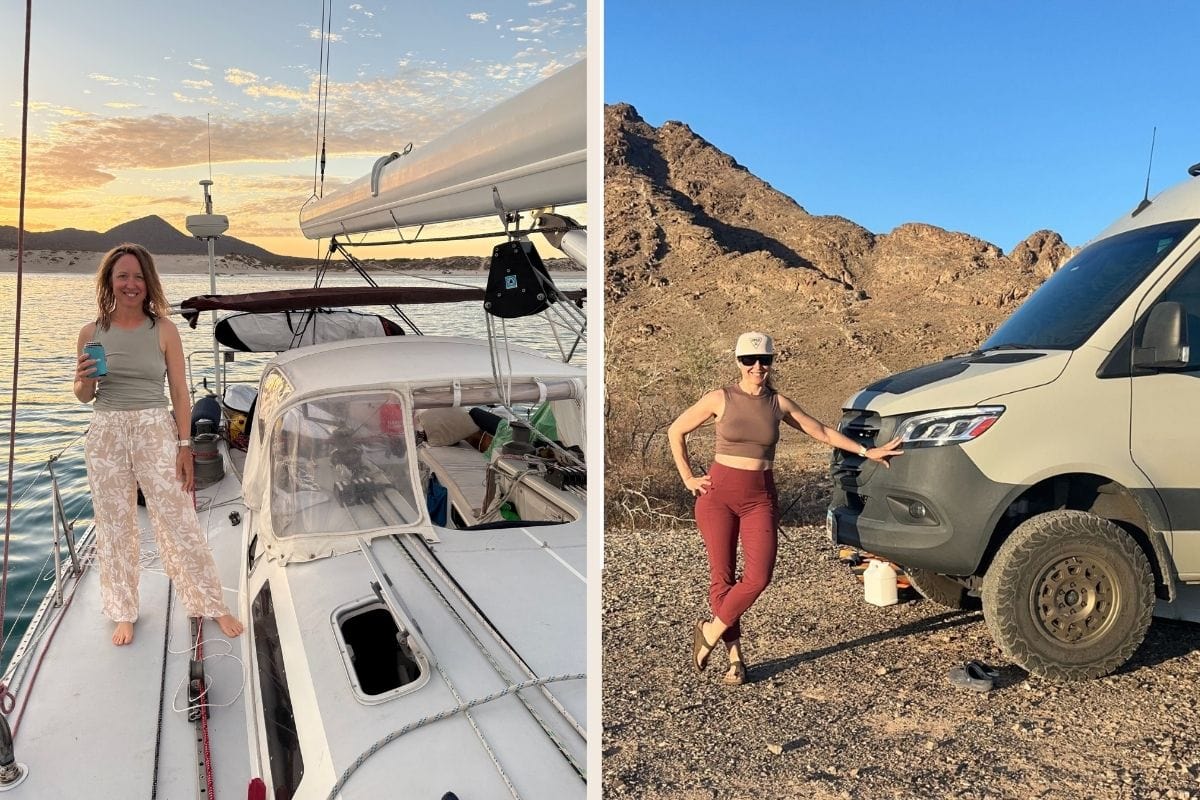
*This post may contain affiliate links. Please read our disclosure policy for more info.
When I tell people I live part of the year in a campervan in the U.S. and part of the year on a sailboat in Mexico, I always get the same question: Which one’s better?
The truth is, van life and sailboat life are two sides of the same coin. Freedom, adventure, closeness to nature, self-reliance, and off-grid capabilities. I love that I see these two lifestyles go hand in hand so often, where sailors have campervans and truck campers for the hurricane season months.
I’ve lived in a Toyota Prius, a Chevy Astro, a Sprinter van, a 1972 CT-41, and now also a Nelson/Marek 46′. I haven’t lived in a “real” house since 2016.
Both lifestyles have taught me lessons, tested my patience, and given me memories I’ll never forget. So, let’s dig in: van life vs. sailboat life—what’s really better, and can they even be compared?
Freedom and Mobility: Tie

One of the biggest draws of van life is the flexibility. You can drive to the mountains, the desert, or a friend’s driveway in a single day. Don’t like the weather? Turn the key and move, and you’ll get there fast.
It’s also WAY EASIER to go grocery shopping and find basic amenities in a van. You just drive up to the store’s entrance, park, and load up.
Sailboat life offers mobility, too, but it’s slower and completely tied to the weather. We’ve had passages where we waited days, or weeks, for the right wind and sea conditions. Sailing the Sea of Cortez is an adventure, but it’s not the same as hopping on the highway.
And groceries? Way harder. We have to anchor outside of a town, take the dinghy down, row to shore, and either walk or get a taxi to the grocery store. And we have to plan our food very carefully as grocery stores in the Sea of Cortez are few and far between.
But with a sailboat, we have the freedom and mobility to anchor in the most beautiful, remote spots. We can go to nature that is untouched by humans, and for that, there is no comparison.
Cost of Living: Van Life Wins

People often think boat life or van life is cheap. The truth: it depends.
In our van, our main costs are diesel, food, maintenance, and the occasional campground. With boondocking, we can go weeks without paying for a spot. However, diesel can really add up in the summer months when we take cross-country road trips, topping out at $800 monthly. And we just purchased $250 worth of Mercedes oil, which Tom puts in himself, saving us a $700 service bill at the dealership.
On the sailboat, marina fees, haul-outs, and constant repairs add up fast. As sailors joke: “B.O.A.T. = Bring Out Another Thousand.” Even with Tom doing all the labor himself, our CT-41 eats money.
For us, costs are lower in Mexico than in the U.S.—boatyards and marinas are far cheaper south of the border. Still, neither lifestyle is entirely “cheap.” Both require budgeting, creativity, and living simply.
Comfort and Space: Sailboat Life Wins

In the van, everything is within arm’s reach. I can grab a snack, sit at the table, or stretch out in bed without much effort. But it’s still a tiny space, especially for two people and I really don’t want to live in a van longer than several months at a time. It’s just too small with too few amenities.
I’m always thankful when we go back to the sailboat and have room to stretch out. There’s a stove, an oven, a sink with running water (via foot pump!), and a bathroom and shower. The boat is way better for dark winter months cause we have so much interior space where we can relax and spread out.
Between van life and boat life, I’d choose boat life for the living space.
Neither the campervan or the sailboat is luxurious. Both force you to live minimally. And honestly? That’s part of the appeal.
Safety and Challenges: Van Life Wins
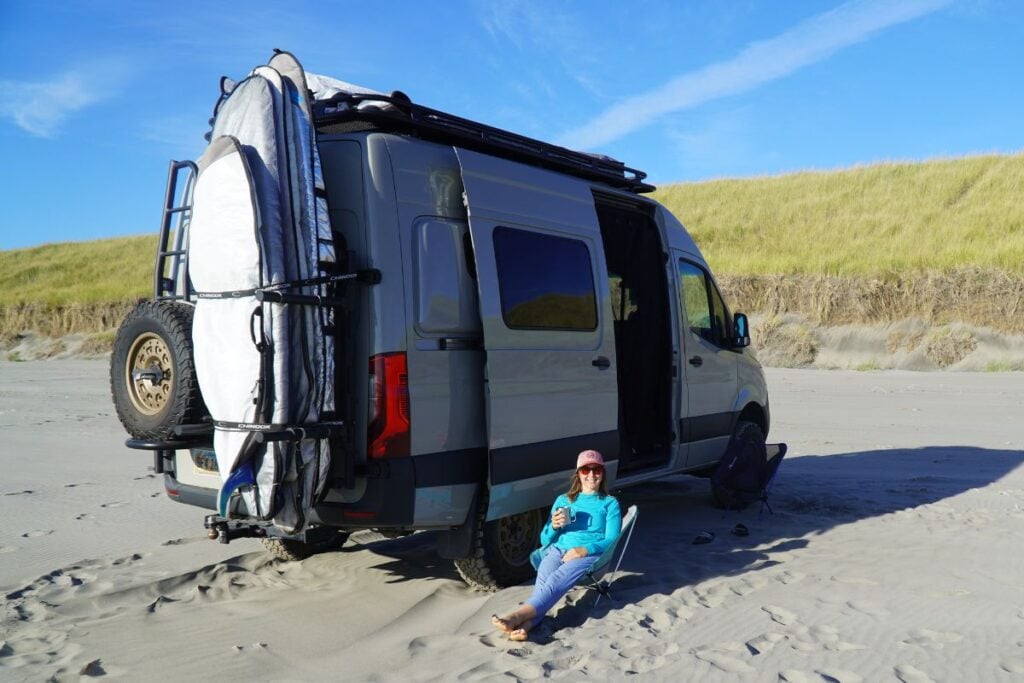
In the van, safety challenges often mean finding a good place to park overnight. We’ve had our share of white-knuckle drives in snowstorms, high winds, or trying to find late-night stealth camping in cities, hoping nobody knocks on the door. But, van life feels very safe, and not dangerous at all compared to traveling on a sailboat.
On the sailboat, you really can be in life-or-death situations. Storms, waves, the chance of falling overboard, system failures, and the sheer unpredictability of the sea. When it comes to safety, there really is no comparison between van life and boat life. Van life is SO EASY in comparison.
One lifestyle deals with cars and parking tickets; the other with Mother Nature herself. Both require resilience, but sailing requires expertise and the ability to remain calm in extremely challenging situations.
Off-Grid Capability: Sailboat Life Wins

Both van life and sailboat life can be surprisingly self-sufficient.
In the van, we rely on solar panels, water tanks, and propane to stay off-grid. Boondocking in the desert or forest feels like true independence. But we still have to pay for diesel to get from place to place.
On the sailboat, our off-grid setup is even more robust: solar, batteries, a watermaker, and sails. I love that we can travel using the power of the wind and that we don’t have to rely on constantly refueling our diesel tanks. Out at anchor, we can go weeks without needing shore.
If complete self-sufficiency appeals to you, boat life takes it to the next level.
Connection to Nature: Sailboat Life Wins
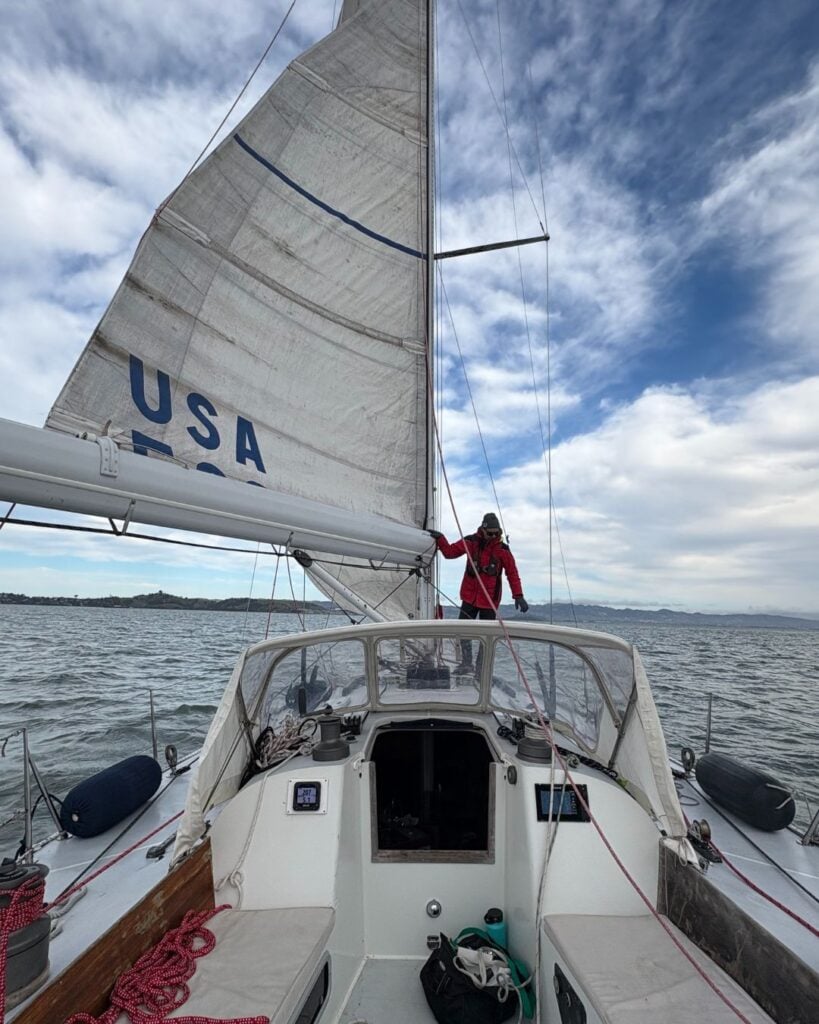
Both lifestyles reconnect you with the outdoors in ways a house never can.
In the van, we’ve woken up in forests, by rivers, and in wide-open deserts. Morning coffee tastes better with pine trees outside the window.
On the boat, nature feels even closer. We’ve watched dolphins play in our wake, stared at star-filled skies from the cockpit, and listened to waves lap against the hull while falling asleep. One of my favorite memories is being anchored near a remote island in the Sea of Cortez at night, watching the phosphorescent outline of sea lions as they played near the boat.
Plus, when you’re out sailing and the wind fills the sails and propels the boat forward, you feel truly one with nature. There is no comparison at all with van life.
Extreme Self-Reliance: Sailboat Life Wins

One of the biggest lessons from both van life and sailboat life is that you have to become extremely self-reliant. There’s no landlord, no handyman, no utility company to call when something breaks. It’s all on you.
In the van, this often means learning how to manage your electrical system, fix plumbing for your water tanks, or troubleshoot an inverter. Something as simple as a blown fuse can derail your trip if you’re not prepared.
On the sailboat, the stakes are even higher. Every system—from the engine to the rigging to the head—has to work properly, and often in remote places where parts and help are hard to come by. I’m very thankful that my partner Tom is an electrical contractor who knows how to fix…..everything.
For some people, this is a downside. For others, it’s empowering. But compared to van life, sailboat living is another animal entirely when it comes to self-reliance.
Community and Lifestyle: Sailboat Life Wins

Van life has exploded in popularity, and with it, meetups, gatherings, and a huge online community. You can find like-minded nomads in almost every town. However, I haven’t personally taken advantage of this, and when we boondock far off-grid, we aren’t near people at all and don’t really want random people coming near us. You never know who is living in a van.
With sailboat life, there’s a small and very tight-knit community. If you are cruising on a sailboat, you have a particular set of skills and outlook on life. I’d say sailors are cut more from the same cloth than van lifers, who can really run the spectrum. At the boatyard and at anchorages, we are always able to make instant friends. Sailors share tools, food, sundowners in the cockpit, and crazy sailing horror stories. The friendships often feel deeper because everyone knows how hard this lifestyle can be.
Both offer community, but I think the sailing community is more robust.
Work and Connectivity: Van Life Wins
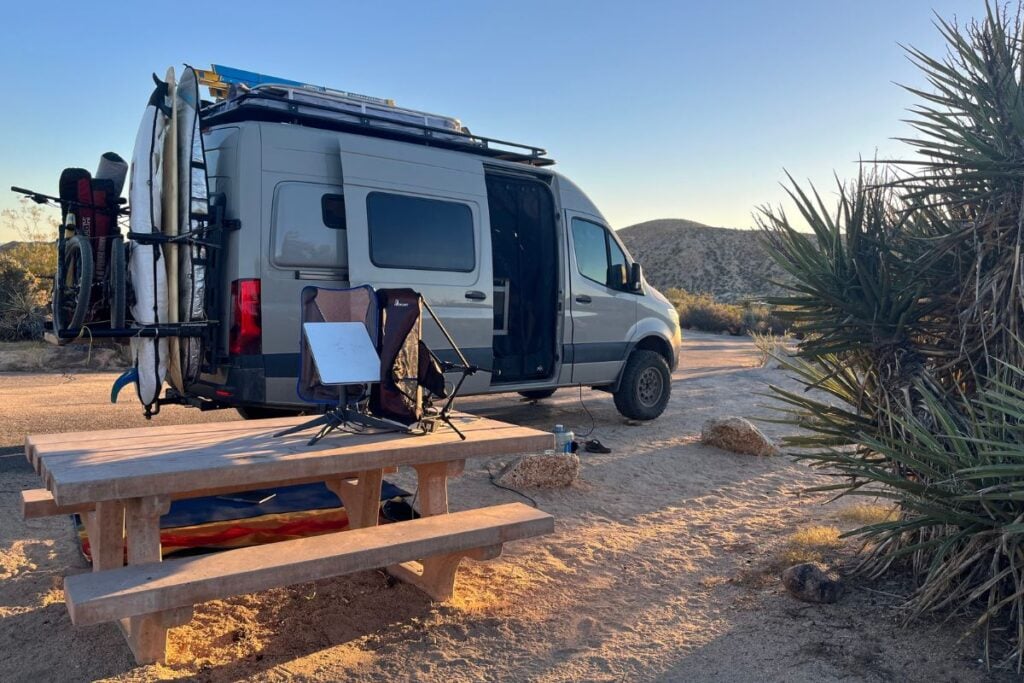
Running The Wayward Home (here’s an article on how I afford my nomadic lifestyle) depends on internet access, so connectivity is huge for me.
In the van, it’s relatively easy: just set up Starlink with a clear view of the sky, or use my Visible cell phone hotspot.
On the sailboat, it’s harder. Starlink helps, but weather, rough seas, and remoteness can make reliable internet tricky. Long passages on the ocean necessitate the use of Starlink’s ocean data, which is expensive and adds up quickly.
If you’re working remotely full-time, van life is more forgiving. Sailboat life requires flexibility.
Exercise and Staying Active: Van Life Wins

This one’s easy: exercise is WAY easier in the van.
On the road, I can mountain bike, hike, go on long walks, or hit the gym. Having a Planet Fitness membership means regular showers and workouts.
On the boat, options are limited. Sure, I can swim or paddleboard, and Tom and I do band exercises in the cockpit. But on passage, movement is hard. After six days at sea down the Baja Peninsula, I was stir-crazy from lack of exercise.
If fitness is a priority, van life wins.
Showers and Bathrooms: Sailboat Life Wins
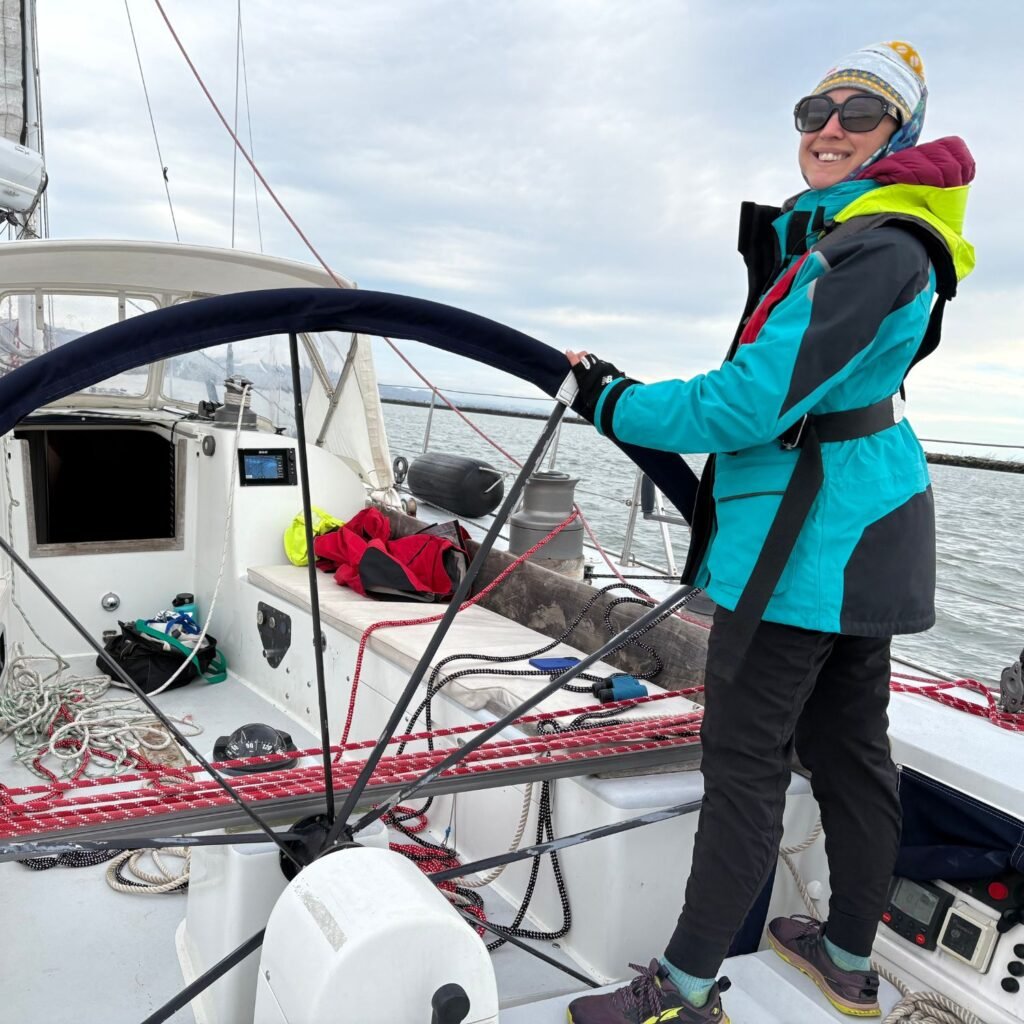
The glamorous topic nobody likes to talk about: bathrooms.
In the van, most people rely on gyms, campgrounds, or portable setups. We have a membership to Planet Fitness just for the hot showers and bathrooms. It’s not always convenient, but it works.
On the sailboat, we do have a toilet (head), but it comes with quirks: pump-outs, holding tanks, and that lovely sound of the pump handle. For years, we didn’t have a working shower. I’ve washed my hair in the sink and used washcloths more times than I’d like to admit. Now, we do have a working shower on both of our sailboats, and I love showering in that enclosed space.
At marinas, showers are better, but when anchored, water conservation means often showering in salt water. Sailboat showers rarely feel luxurious.
If daily long, hot, endless showers are non-negotiable, neither lifestyle will make you happy.
So… What’s Better?
Here’s the thing: neither lifestyle is “better.” They’re just different.
Van life is perfect for people who want mobility, consistent internet, easy exercise, and access to everyday conveniences.
Sailboat life is for those who crave slower rhythms, deeper connection to nature, and true self-sufficiency—if they’re okay with the challenges and mechanical know-how that come along with it.
For Tom and me, the answer isn’t either/or—it’s both.
We spend summers in our van, roaming the U.S., mountain biking, hiking, and chasing perfect weather. Winters, we return to our CT-41 and Nelson/Marek in Mexico, soaking up sunsets, watching dolphins, and enjoying the power of the wind in the sails.
Both lifestyles have their downsides: the repairs, the costs, the tiny spaces. But both have given us freedom, simplicity, and a way of life that feels authentic.
Which one would you choose?







You mentioned the hassle of grocery shopping while on a sailboat. I am wondering if you like to fish — either for enjoyment or for diet needs.
Thanks,
Barbara
I enjoy your articles.
Yes! We do enjoy fishing 🙂